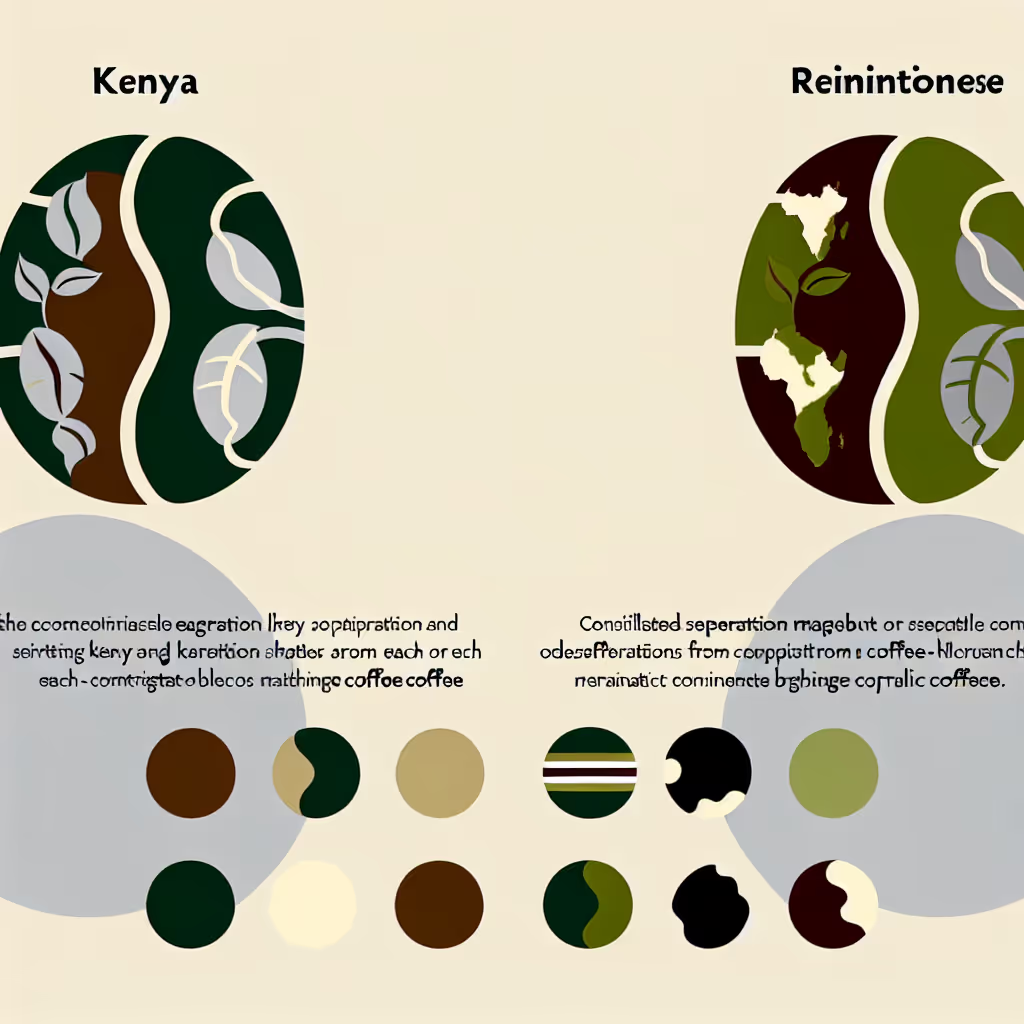Kenyan Vs. Burmese Coffee
This comparison explores the unique qualities of Kenyan and Burmese coffee beans, highlighting their distinct flavor profiles, growing conditions, and processing methods to help coffee enthusiasts make informed choices.

Brief Description
Kenyan coffee is renowned for its bright acidity, full body, and complex flavor profile. Grown in the rich volcanic soils of the Central Highlands, these beans benefit from ideal climate conditions and meticulous processing. The result is a cup that's bold, wine-like, and often described as the 'connoisseur's choice'. With notes ranging from blackcurrant to citrus, Kenyan coffee offers a truly unique and memorable tasting experience.
Myanmar coffee, a hidden gem in the specialty coffee world, is gaining recognition for its unique flavor profile. Grown primarily in the mountainous Shan State, these beans offer a delightful combination of sweetness and complexity. With a relatively young coffee industry, Myanmar is quickly establishing itself as a producer of high-quality, distinctive coffees that reflect the country's rich cultural heritage and diverse growing conditions.
Importance of Comparison
Comparing Kenyan and Burmese coffee is crucial for coffee lovers seeking to expand their palate and explore lesser-known origins. While Kenyan coffee is well-established in the specialty market, Burmese coffee is an emerging gem. Understanding their differences helps consumers appreciate the diversity of coffee flavors and supports sustainable farming practices in both regions.
Key Attributes
Origin
Kenyan
Burmese


Consumer Guide
When choosing between Kenyan and Burmese coffee, consider your flavor preferences. If you enjoy bright, bold coffees with wine-like acidity and complex fruit notes, Kenyan coffee is an excellent choice. Opt for pour-over or French press brewing to highlight its unique characteristics. For those seeking a more balanced cup with chocolate notes and subtle citrus undertones, Burmese coffee offers a delightful alternative. It performs well in espresso-based drinks and pour-over methods. Consider trying both origins side-by-side to appreciate their distinct qualities. Look for beans from reputable roasters who provide information on farm origin and processing methods to ensure the best quality and flavor experience.
Expert Opinions
Coffee expert James Hoffmann notes, 'Kenyan coffee often showcases a vibrant acidity that's unmatched, while Burmese coffee surprises with its balanced sweetness and complexity.' Specialty roaster Maria Rodriguez adds, 'The emergence of Burmese coffee in the specialty market is exciting. It offers a unique flavor profile that sits between the boldness of African coffees and the smoothness of South American beans, making it a versatile choice for various brewing methods.'
FAQs
Kenyan coffee is known for its bright acidity, full body, and complex flavors including blackcurrant, citrus, and floral notes. Burmese coffee offers a more balanced profile with chocolate, citrus, and floral notes, typically with less acidity than Kenyan beans.
Kenyan coffee is primarily grown in the Central Highlands at altitudes of 1400-2100m in volcanic soils. Burmese coffee is mainly cultivated in the Shan State at slightly lower altitudes of 1000-1500m. These differences in altitude and soil contribute to the distinct flavor profiles of each origin.
Both Kenyan and Burmese coffees excel in pour-over and French press methods. Kenyan coffee is also great for cold brew, while Burmese coffee performs well as espresso. Experiment with different methods to find your preferred way of highlighting each origin's unique characteristics.
Kenya produces significantly more coffee, with an annual output of around 50,000 metric tons. Myanmar's coffee industry is smaller and growing, with an annual production of about 8,000 metric tons. This difference reflects Kenya's established position in the coffee market and Myanmar's emerging status.
Kenyan coffee is typically washed, often using a double fermentation process, and sun-dried. Burmese coffee employs a variety of methods including washed, natural, and honey processing. These different techniques contribute to the unique flavor profiles of each origin.
Kenyan coffee often commands higher prices due to its established reputation and complex flavor profile. Burmese coffee, being a newer entrant to the specialty market, is generally more affordable but prices may vary depending on quality and availability. As Burmese coffee gains recognition, prices may increase.
Conclusion
Both Kenyan and Burmese coffees offer unique and rewarding experiences for coffee enthusiasts. Kenyan beans shine with their bright acidity, full body, and complex fruit notes, making them a favorite among connoisseurs. Burmese coffee, with its balanced sweetness and emerging presence in the specialty market, provides an exciting alternative with chocolate and subtle citrus notes. Whether you prefer the bold, wine-like qualities of Kenyan coffee or the smooth, versatile nature of Burmese beans, exploring these origins will expand your coffee horizons and support diverse coffee-growing regions.






